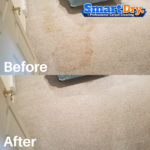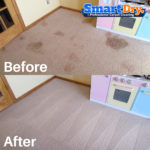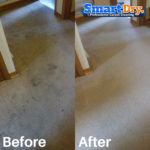Stain Removal Tips San Diego
Stains can strike your upholstery and carpets at any time. Fortunately, many of them are fairly easy to deal with- but only if you approach them in the right way. While you might naturally reach for a wet towel and start scrubbing at the stain, this is actually the last thing you should do. You could easily end up setting the stain even deeper in- but luckily, we’re here to put you on the right path because we have the best stain removal tips in San Diego. Read on to learn some simple yet effective home stain treatments.
If you immediately clean up the stain, then more often than not you’ll be able to completely eradicate it by yourself. Don’t use any hot substances, though, since this can set the stain and prevent you from removing it properly later on. Your first step should be to blot the spilled liquid, rather than scrubbing it. At the same time, try to collect any solids before they get trodden into the carpet- but be careful, as you don’t want to accidentally spread the stain any further.
If you’re planning on using any chemical solutions to clean up spots and stains, then it’s a good idea to test this out on a small space on your carpet first. Our green carpet cleaning process used to remove spots and stains, for example, eliminates the use of harsh chemicals. Harsh chemicals can react badly with some carpet materials, and if you pour a large amount onto the carpet, you could therefore wind up doing some serious damage. Instead of letting this happen, place a tiny amount on a spot in your carpet that’s not easily noticeable. If it seems okay to you, then use the chemical cleaner on the stain, and work your way in from the outside. This will limit the amount that the stain is able to spread, so if you can’t shift the center, you will at least be left with a smaller stain to contend with later on.
After you have left the chemical cleaner on for the amount of time suggested on the packaging, you should then rinse it out with some water. Then, blot the stain further to collect up as much of the moisture as possible, and then brush the carpet to lift out any remaining materials. An alternative approach is to put a towel over the wet area, and then place something heavy on top of the towel to keep it fixed to the carpet. Leave it to soak up the stain overnight, and the majority of the stain should be removed. This technique could be used on area rugs, upholstery and of course on any carpet surface that may need that special care to keep it looking clean and spotless.
If you’d rather not use chemical cleaning products, then here are a few homemade solutions that you can use:
This solution works well on most common household stains, so if you spill a drink on your carpet, this should be the first thing you reach for.
This works best on pet urine, as well as any other stains causing a bad odor.
As we mentioned earlier, any stain solution works best when you use it immediately. The worst thing you can do with a stain is to just leave it, as you’ll only be making things harder for yourself later on. Start to clean the stain immediately, though, and there’s every chance you can completely eradicate it by yourself.
Keeping your carpet clean- a few handy tips
To keep the amount of dirt that gets into your carpets to a minimum, then you’ll want to do all you can to stop soil and other substances from getting trodden into them. For that reason, it’s a good idea to take your shoes off before walking over your carpets. Alternatively, keep a strong, solid doormat by the front door so that people can wipe their feet before they come in.
You should also regularly vacuum your carpets to collect surface soil, rather than allow it to sink into the fibers of your carpet. Make sure you buy a vacuum cleaner that’s easy to use, so you aren’t put off cleaning by a vacuum that you struggle with. It’s all about being thorough, so within four feet of the front and back door, pass over the carpet at least a dozen times. About eight passes will be enough for areas that see a lot of footfall, and four are plenty for less used areas. If you have a carpet that hasn’t been cleaned for a long time, then double this routine until the carpet starts to look a little fresher.
With area rugs, rather than fitted carpets, the easiest way to get a deep clean is to just roll them up and take them to a professional carpet cleaner. If the carpet can’t be moved, though, then we’ll be more than happy to come and take care of things for you, using our special low-moisture carpet cleaning process. You should ideally stay away from using a lot of water on your carpets, as this can lead to a buildup of mold and mildew.
Spot cleaning: a beginner’s guide
Blotting
Your first step with any stain should be to blot it, rather than scrubbing it. Rubbing a stain will only end up pushing it deeper into the carpet, and can also mat the fibers of your carpet to spoil their appearance even further. Rather than taking that approach, blot at any spilled liquids using a towel, or with some thick paper towels- using a few at once tends to work best. Push down with the palm of your hand, and keep going until you’ve soaked up all the liquid. If you’ve got a wet-dry vacuum, then these can also be used for this stage to collect any excess before you blot the stain.
Dishwashing Soap
As well as leaving your cutlery sparkling clean, dishwashing soap also works wonders at removing stains. Whereas laundry detergent can be a bit too harsh, and hand soaps tend to leave sticky residue behind, dishwashing soap is perfect for tackling stains. Be careful to only use a small amount, though- otherwise, you’ll end up completely soaking the carpet with suds.
Rinsing
Whether you use dishwashing soap or one of the cleaning solutions we mentioned earlier, be sure to rinse them out properly. You can either mist-clean the area with a squirt bottle, or use a wet towel to blot at the stained area. Keep repeating this until there’s no more residue left in the carpet. Remember, don’t rub at it- instead, be gentle to protect the carpet fibers.
Keeping your home free from dust and allergens
Leave your carpet for too long without cleaning it, and there will come a time where it simply cannot absorb any more dust- meaning those particles are instead left floating around the air in your home. These can be especially problematic to those with asthma, and with more and more children suffering from this chronic disease, it’s important that you do something about the dust in your home to give allergy relief to those affected. A lot of vacuum cleaners only make the problem worse by blowing any excess dust out of your carpets and into the air. Luckily, many newer models use a component known as HEPA (or high efficiency particle arresting) filters to ensure that they collect up all of that dust.
However, be warned that just because a vacuum has a HEPA filter fitted, that doesn’t necessarily mean that it’s going to be collecting all the dust it comes across. Instead, keep an eye out for the “green label” award given by the Carpet and Rug Institute. To be given this award, a vacuum must not cause more than 100 micrograms of dust per cubic meter of air- a tiny amount that’s about equivalent of shaking your hair a couple of times.
Cleaning your carpets: a step by step guide
Synthetic carpets
In general, synthetic carpets are pretty easy to clean. Just make multiple passes with your vacuum in different directions, and be sure to use the beater brush if your vacuum comes with one. You’ll want to empty the vacuum bag when it’s only about halfway full, since after this point, your vacuum’s efficiency takes a big hit. With liquid spills on synthetic carpets, use the blotting technique that we mentioned earlier. If you spot any discoloring after a spill, then it probably means there’s some residue left behind that’s collecting more dirt- so blot the area with warm water to solve the problem.
If you want to try deep cleaning a synthetic carpet by yourself, then you can do this with a steam extraction machine. You’ll want to hire one from a professional company, since the ones you find at the supermarket aren’t particularly powerful. Be sure to air condition the carpet afterwards to get it completely dry.
Wool carpets
In general, wool carpets can be cleaned in much the same way as synthetics. However, you’ll want to be careful to avoid using rotary brushes if your carpet is a Berber carpet, as this can cause some serious damage to the fibers. You should instead opt for a floor tool, or if necessary, a hand-vac to pick up any problem points. Cleaning up spillages is likewise similar to synthetics- mist with water and then blot up the stain. However, make sure you don’t use ammonia, or any other type of cleaning product that’s highly alkaline, as this can damage the wool.
Where wool and synthetics differ most, though, is in how you should approach deep cleaning. It’s advised that you only let the professionals deep clean a wool carpet. Since the fibers absorb water so easily, it’s quite common for people to over-wet their carpets, and then have a lot of difficulty drying them out.
Plant carpets
Again, regular vacuuming is essential with plant carpets. You don’t want to wear them out too quickly, which can easily happen if dirt and grit become trodden into the fibers. Instead, take a beater brush and use it to beat out any grit which may have been trapped within. One thing to be wary of with plant carpets is the fact that they don’t shrug off stains as easily as wool and synthetic carpets. Even if your plant carpet has been treated with a solution designed to repel liquids, that still won’t be enough to completely keep the substances out of your carpet. Instead, you should take care to blot any spills immediately using the method we outlined earlier. To prevent damp from becoming a problem, you’ll want to use a fan or hair drier to evaporate any leftover liquid. However, be sure to set your drier on a low heat, as higher settings can end up damaging the carpet fibers.
As for deep cleaning plant carpets, this is a definite no-no to tackle on your own. You can refer to the best stain removal tips in San Diego for those easy to remove stains. But make sure to call us in order to tackle those difficult deep cleaning projects. In fact, manufacturers explicitly warn customers against using wet and steam cleaning methods on plant carpets, since, like we mentioned earlier, too much liquid can cause some serious damage. Instead, you’ll want to let the experts take care of deep cleaning your plant carpets for you. They’ll know the right ways of going about it, to ensure that your carpet stays completely clean without any lasting damage occurring.







